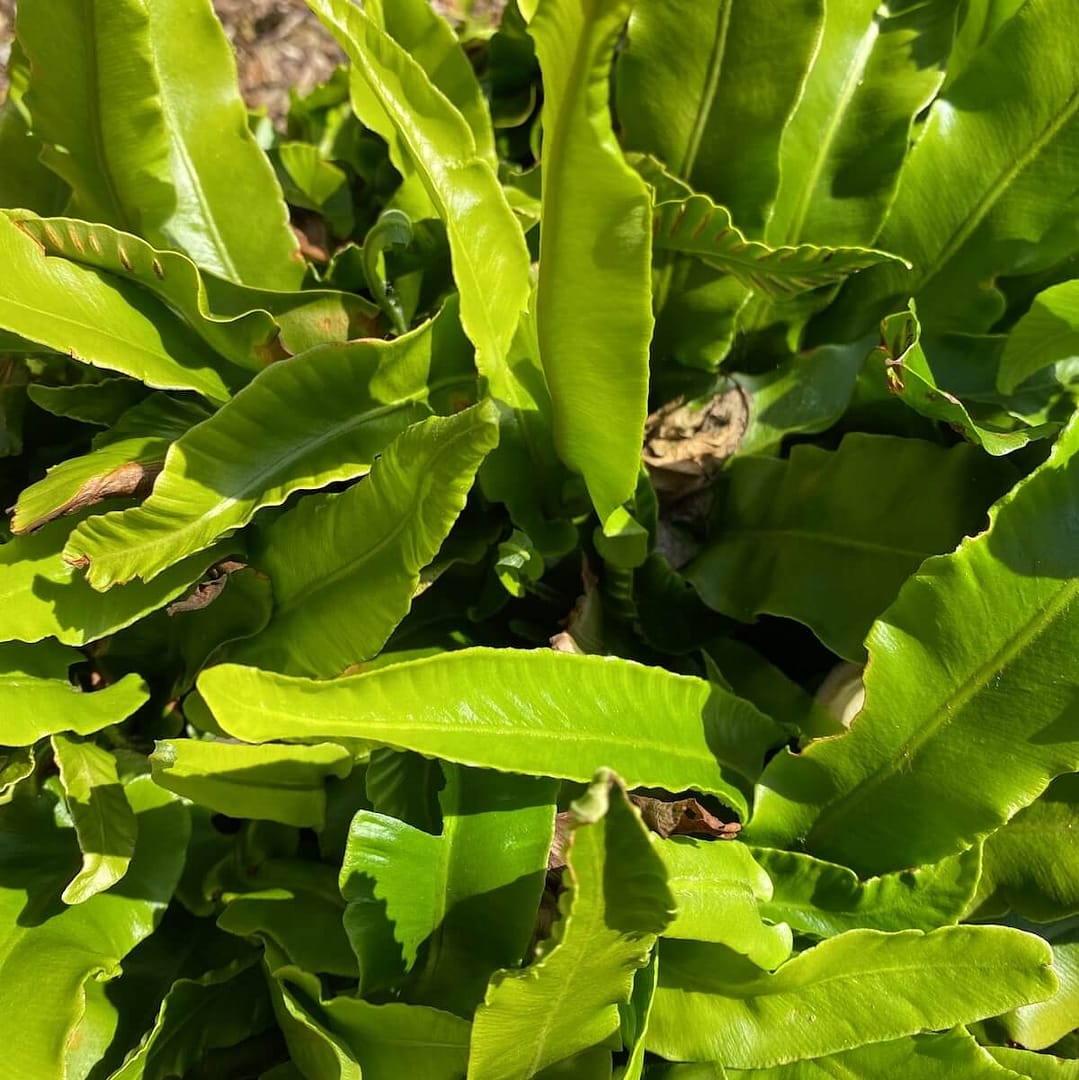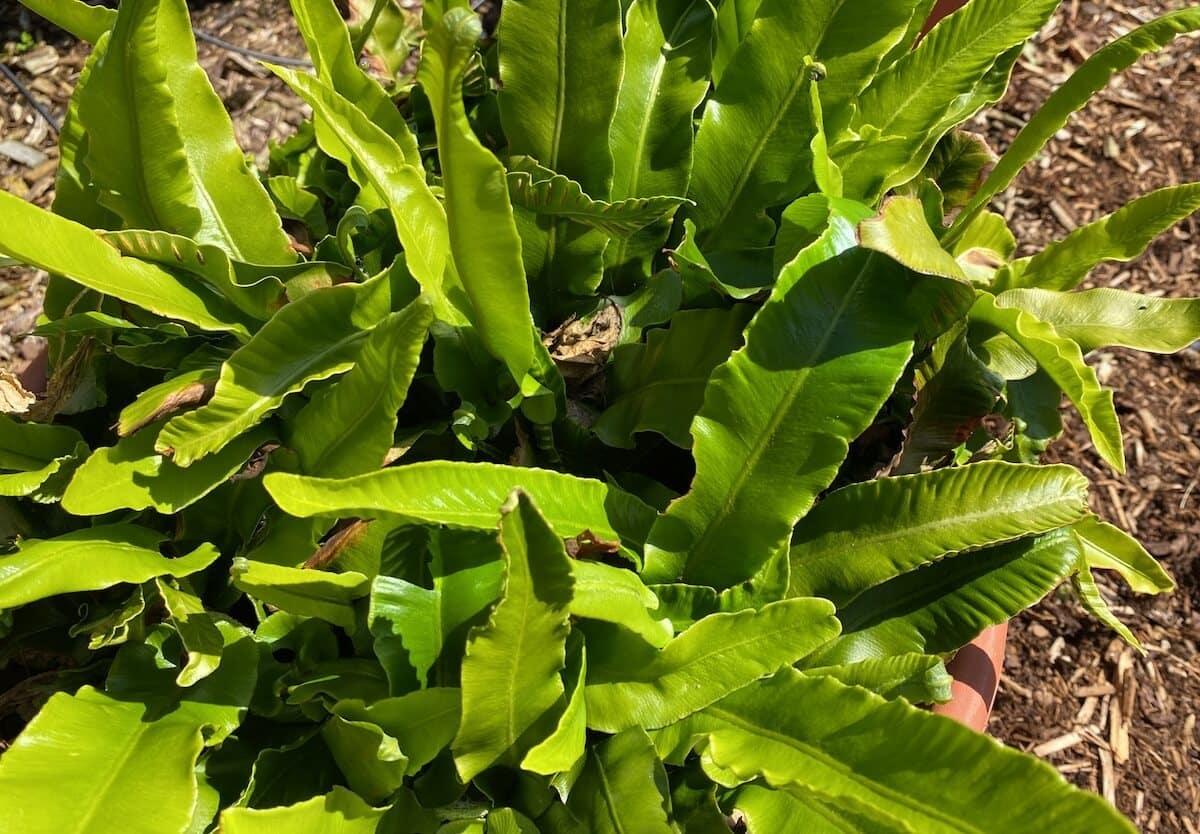
Position
- Partial to full shade
- Sheltered from strong winds
- Suitable for woodland gardens and shady borders
- Can be grown in wall crevices or rocky areas
Hardiness
- Tolerates temperatures down to -20°C (-4°F)
- Evergreen in sheltered positions
- Performs well in a variety of UK climates
Soil
- Well-draining, rich soil
- Can adapt to lighter clay or chalk soils
- Dislikes heavy, waterlogged conditions
- Prefers alkaline to neutral pH
- Ideally suited to slightly alkaline conditions
- Grab a soil test kit and ensure the perfect conditions for growth
Height
- Height: 30-60cm (12-24 inches)
- Spread: 30-45cm (12-18 inches)
- Forms dense clumps over time
Seasons of Interest
- Fresh growth appears in spring with vibrant green fronds
- Maintains colour throughout the growing season
- Evergreen nature provides year-round interest
- No flowering since it is primarily ornamental for foliage
Foliage:
- Strap-like, glossy fronds with a deep green colour
- Distinctive shape with a rosette growth pattern
- Remains attractive throughout the year
Additional Notes
- Low maintenance once established; minimal care required
- Regular mulching can help retain soil moisture
- Excellent for encouraging wildlife, providing shelter and habitat
- Can be susceptible to crown rot in overly wet conditions
- Thrives in cooler, damp climates and suits urban gardens well
- Non-invasive and makes a great addition to both traditional and contemporary garden designs
- Great for low-light areas where other plants may struggle to thrive
Asplenium scolopendrium: The Distinctive and Dependable Hart’s Tongue Fern
Asplenium scolopendrium, commonly known as the Hart’s Tongue Fern, is one of Britain’s most recognisable and enduring native ferns. Its striking, strap-like fronds and glossy evergreen foliage bring bold texture and year-round structure to shaded gardens. This low-maintenance fern has rightly earned the prestigious RHS Award of Garden Merit, reflecting both its visual appeal and garden performance. Its architectural form and vibrant green colouring make it a standout choice for gardeners looking to enrich darker corners with lasting interest.
Unique Appearance and Growth Habit
Unlike most ferns, which feature finely divided fronds, Asplenium scolopendrium forms rosettes of broad, undivided leaves. These arching, tongue-shaped fronds typically reach 30–60cm (12–24 inches) in height and maintain an upright to slightly cascading form. Each frond emerges bright green in spring, gradually developing a polished, leathery sheen that persists through winter. The undersides of mature leaves reveal distinctive linear spore patterns, adding subtle visual detail. The combination of upright habit and simple form lends this fern substantial architectural value, making it equally at home in traditional woodland gardens or contemporary planting schemes.
Ideal Conditions for Thriving Growth
The Hart’s Tongue Fern flourishes in partial to full shade and appreciates consistently moist conditions, although it tolerates brief dry spells once established. It performs exceptionally well in alkaline or lime-rich soils but remains adaptable to various garden environments, including chalky, clay, and humus-rich soils. Good drainage is important, especially in winter, to prevent crown rot. Its compact, fibrous root system allows it to settle happily into borders, shady crevices, and even the narrow gaps between stones in old walls, giving gardeners plenty of creative freedom.
Seasonal Interest and Evergreen Impact
One of the fern’s standout features is its ability to provide an evergreen structure. In early spring, fresh fronds unfurl in a vivid green, bringing brightness and life to shaded spots emerging from winter dormancy. By summer, the foliage has a rich, glossy appearance that reflects light and contrasts with softer, more finely textured plants. The evergreen leaves remain in place even through the colder months, offering resilience and visual continuity when other perennials have retreated.
Garden Design and Versatile Uses
Few ferns match Asplenium scolopendrium for sheer versatility. It is an excellent candidate for shaded borders, underplanting schemes, damp rockeries, and woodland edges. Its distinctive form and evergreen nature allow it to act as a feature plant and a harmonious background accent. Planted en masse, it brings a cohesive, sculptural quality to woodland designs, while single specimens shine in natural stone walls, old troughs, or beneath trees. The contrast between its simple, strap-like fronds and the textured leaves of hostas or pulmonarias enhances layered planting combinations with ease.

Simple Care and Low-Maintenance Needs
Once established, the Hart’s Tongue Fern is notably undemanding. It requires occasional tidying and an annual mulch to remain healthy and vibrant. Remove any dead or damaged fronds as needed, ideally in early spring before new growth begins. A yearly application of leaf mould or composted bark helps to retain moisture, improve soil structure, and support sustained growth. Regular watering during extended dry periods benefits container-grown specimens or plants in more exposed locations.
Best Planting Practices
The most favourable time to plant Asplenium scolopendrium is in spring or autumn, when the soil is moist and workable. Space plants are approximately 30cm (12 inches) apart for natural spread and airflow. Incorporating well-rotted organic matter at planting time boosts drainage and fertility, giving new plants the best start. While tolerant of poor soil, the fern will thrive when supported by enriched, moisture-retentive yet free-draining conditions.
Soil Preferences and Growing Medium
This fern favours alkaline to neutral soils, performing particularly well in chalk or limestone-rich areas. However, it will adapt to various soil types provided adequate drainage is maintained. In wetter or heavier clay soils, adding grit and compost helps create the open structure to prevent waterlogging. The plant’s resilience allows it to grow in formal garden beds and more challenging microclimates, such as shady, rocky outcrops or beneath established trees.
Growing in Pots and Containers
Thanks to its compact root system and slow-growing habit, Asplenium scolopendrium is well-suited to container gardening. Choose deep pots—ideally 30cm (12 inches) or more—with good drainage holes. Use a loam-based, moisture-retentive compost amended with grit for improved drainage. Regular watering and occasional feeding with a balanced, organic liquid fertiliser during spring and summer will help maintain lush foliage. Container specimens are ideal for shaded patios, courtyard gardens, and balcony displays, bringing evergreen texture to hard landscaping.
Companion Planting and Design Combinations
The Hart’s Tongue Fern pairs beautifully with a variety of shade-loving perennials. Its bold foliage effectively contrasts with the soft textures of hellebores, tiarella, and epimediums while harmonising with spring bulbs like snowdrops and wood anemones. When combined with other ferns of differing shapes—such as the delicate Athyrium filix-femina or the finely divided Dryopteris erythrosora—it contributes to a richly layered, naturalistic effect. In more contemporary designs, its simplicity complements minimalist planting palettes and clean architectural lines.
Resilience, Hardiness, and Problem-Solving
Asplenium scolopendrium is a robust and resilient fern with few pest or disease issues. Its evergreen fronds may show occasional browning during prolonged droughts or if exposed to wind scorch, especially in colder areas. Simply remove affected leaves to keep the plant tidy. It is fully hardy across the UK, tolerating winter temperatures as low as –20°C (–4°F). It will reward even minimal care with years of consistent growth in sheltered, moisture-retentive sites.
From Darren’s Patch
I’ve always had a soft spot for the Hart’s Tongue Fern — it’s one of those dependable plants I turn to repeatedly when I need to lift a dark or tricky corner of the garden. Its bold, strap-like fronds add an architectural elegance that few other shade-lovers can match, and I love how it holds its form right through winter when most plants have long disappeared. I’ve tucked it into the crevices of old stone walls, nestled it at the base of trees, and even grown it in containers on a shady patio — it never fails to impress. It’s not just beautiful; it’s also wonderfully low-maintenance, which means more time enjoying the garden and less fussing over it. Asplenium scolopendrium is one of those classic native ferns that truly earns its keep.
![]()
Final Thoughts
Asplenium scolopendrium remains one of the UK gardens’ most visually distinctive and easy-going ferns. Its strap-like, glossy fronds deliver texture, interest, and evergreen presence in even the shadiest corners. Whether used to soften stonework, anchor a woodland edge, or bring architectural form to a shady courtyard, the Hart’s Tongue Fern continues to prove its worth year after year.
Its adaptability, resilience, and timeless elegance make it an essential addition to traditional and contemporary planting schemes. For gardeners seeking bold foliage with minimal maintenance, this enduring native fern delivers a rewarding and refined solution for shaded spaces.
Check out the RHS article here.
Want to learn about other fern varieties? Read about the Lady Fern here.
For more information on ferns for your garden, please check out our guide to ferns for UK gardens.
Frequently Asked Questions
Q: How tall does Hart’s Tongue Fern grow?
A: Asplenium scolopendrium typically reaches 30-60cm (12-24 inches) in height. The strap-like fronds form attractive rosettes that maintain good shape throughout the year.
Q: What growing conditions does this fern prefer?
A: This adaptable fern thrives in partial to full shade. It grows particularly well in alkaline soils but tolerates most conditions if drainage remains good.
Q: How hardy is Hart’s Tongue Fern?
A: This tough native fern withstands temperatures below -20°C (-4°F). It stays evergreen through winter and performs well throughout the UK.
Q: Will it grow on my garden wall?
A: Yes, Hart’s Tongue Fern grows excellently in wall crevices. The compact root system establishes well in lime mortar joints and natural stone walls.
Q: Does it need much maintenance?
A: Once established, Hart’s Tongue Fern needs minimal care. Remove any damaged fronds and apply mulch annually to maintain soil moisture.
Q: Can I grow it in containers?
A: Yes, this fern grows well in containers. Use pots at least 30cm (12 inches) deep with good drainage holes and quality potting mix.
Q: How often should I water it?
A: Water regularly during the first growing season to establish strong roots. Established plants need watering only during prolonged dry spells.
Q: What plants combine well with Hart’s Tongue Fern?
A: This fern pairs beautifully with hellebores, pulmonaria, and woodland bulbs. The glossy, evergreen fronds provide year-round structure among seasonal plants.
Q: How do I deal with brown fronds?
A: Simply trim off any brown or damaged fronds at their base. New growth will emerge during the growing season to maintain the plant’s appearance.
Q: Why did my fern receive the RHS Award of Garden Merit?
A: The award recognises this fern’s outstanding garden performance, reliability, and growing characteristics. It proves consistently good in UK gardens.
